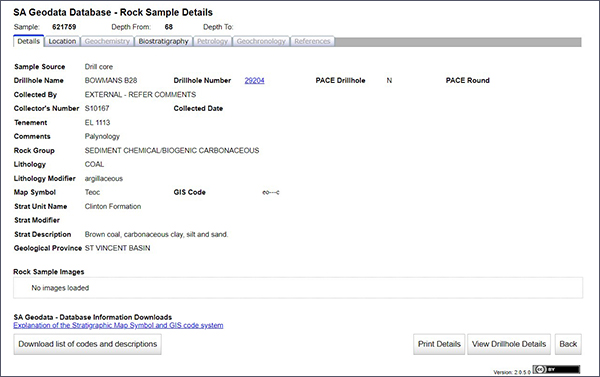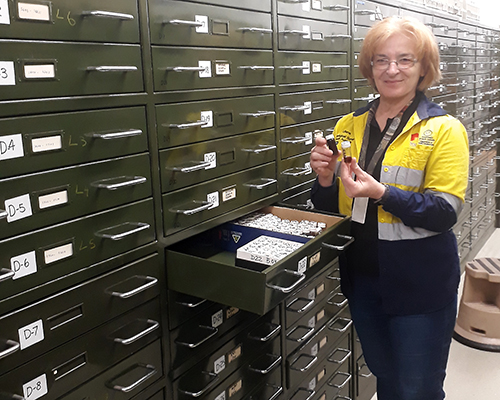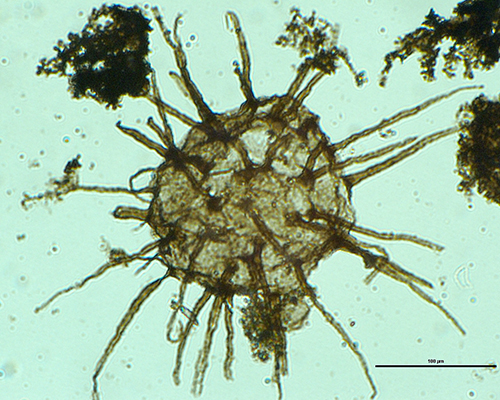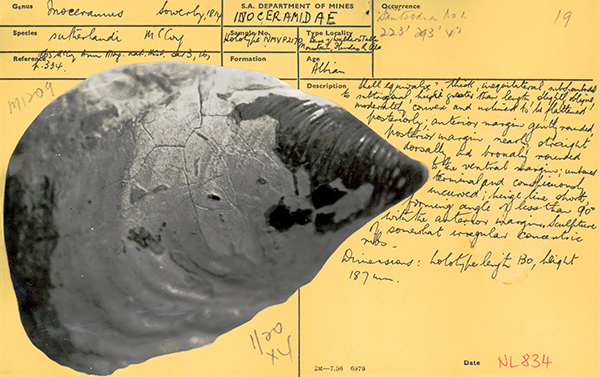A rich paleontological collection and accompanying database.
The Geological Survey of South Australia (GSSA) is custodian of an extensive paleontological collection resulting from over 70 years of in-house biostratigraphic services. The collection is available for viewing at the South Australia Drill Core Reference Library.
Liliana Stoian with sample specimen vials in the paleontology storeroom at the South Australia Drill Core Reference Library. (Photo 418472)
It includes South Australian fossil specimens and records (e.g. index cards and museum registers); hand specimens; casts; moulds; microfossil slides and thin sections (palynology, plant cuticles and acritarchs); and microfossil samples (foraminifera and ostracods).
The records date back to 1949, with specimens collected and analysed in-house by Nell Ludbrook, and continued later by Murray Lindsay, Wayne Harris, Barry Cooper, Karen Lablack, Neville Alley, Brian McGowran, Marigold White, Wen-long Zang, Andrew Rowett and Liliana Stoian.
Acritarch (Skiagia ornata) recovered from 169.9 m in historical drillhole Oakvale 1. The sample was analysed in-house as part of the Delamerian National Drilling Initiative project. The analysis results are recorded in the biostratigraphy database against rock sample 3276026. (Photo 418473)
Material (excluding type) can be loaned to researchers from recognised institutions under specific conditions. Contact Liliana.Stoian@sa.gov.au for more information.
The collection is complemented by a biostratigraphic database containing detailed records of over 18,800 rock samples processed for palynology, foraminifera, diatoms, acritarchs, plant cuticles, fossil specimens, molluscs, ostracods, stromatolites, otoliths or macroflora. The database is accessible 24/7 via the South Australian Resources Information Gateway, SARIG.
Preserving and cataloguing the paleontological collection
The main component of the paleontological collection is the molluscs, including type specimens collected and studied by Nell Ludbrook. The GSSA completed an inventory of the type specimen molluscs in 2019. A digital catalogue of 3,080 specimens was compiled, recording fossil field number, location, depth, fossil name, collector, analyst, collecting date (if known), name of the stratigraphic unit (formation, bed etc.), age, number of specimens and storage.
The Nell Ludbrook mollusc collection was donated to the South Australian Museum in March 2021 for better exposure and improved storage facilities. A copy of the audit, including the content of each drawer cabinet, was also provided.
The rest of the mollusc collection (an estimated 5,000 specimens) remains at the core library stored in steel and wooden cabinets. It is yet to be catalogued.
Other fossils in the collection include Cretaceous belemnites holotypes; Early Permian, Early Cretaceous and Eocene foraminifera holotypes; stromatolites; and bones including vertebrae. Additionally, there are plant fossils (wood, leaves, seeds, fruits) collected from Stuart Creek, Golden Grove, One Tree Hill, Leigh Creek and other areas of the state.
The collection also includes vials with processed and unprocessed material (micropaleontology), rock samples collected from type localities and type sections, palynological residue vials and 30,000 palynological slides, including pollen and spore holotypes identified by Wayne Harris in 1966.
A suitable storage environment is required to prevent deterioration and damage. Fluctuation in temperature, relative humidity, the presence of contaminants from dust and exposure to light are the main risk factors. The current location at the modern core library offers good security and protection. A special room is assigned with specimen wooden cabinets and steel cabinets.
A staged approach to cataloguing the whole paleontological collection is underway. The historical index cards for palynology, molluscs and foraminifera – identified as a high-risk category for preservation – were digitised between 2019 to 2021. They contain irreplaceable handwritten data and information about location, taxonomy, age, stratigraphy, depositional environment, laboratory processing and photographs. Over 60,000 index cards were digitised and uploaded to the database. The original index cards have been transferred to State Records.
Handwritten index card for Inoceramus sutherlandi, Nell Ludbrook mollusc collection. (Photo 418474)
Another priority has been checking of historical palynological slides for damage (cracks due to mounting medium, or fungus growing inside cover lid). A total of 5,410 vials with palynological residue were catalogued in 2020. Of these, 230 vials were remounted for preservation. More slides will require remounting.
The foraminifera holotypes, collected and analysed by Murray Lindsay, are the next priority for cataloguing. About 66 holotypes and hundreds of paratypes, hypotypes and topotypes were catalogued in 2021 (Early Permian, Early Cretaceous and Eocene sediments). The majority of foraminifera holotypes were identified and described in the Early Cretaceous sediments from Oodnadatta 1 (SA Geodata drillhole 10133) and Early Permian sediments from Stuart Range Bore 3 (259572). These 2 drillholes are being considered for addition to the South Australia Geoheritage register as they contain unique microfossils that need to be preserved.
Biostratigraphic database
Biostratigraphic data an important source of information for petroleum and mineral exploration and groundwater investigations. Biostratigraphy uses fossil assemblages from rocks to assign relative ages to rock strata. The fossils (macro and micro) are used to identify biozones and geological time periods based on the species that are found within the analysed interval.
The biostratigraphic database comprises results from in-house analyses and those from petroleum and mineral company exploration. The database resides within SA Geodata and is maintained by the GSSA. It is continually added to as the inventory and cataloguing of the physical collection grows. It is intended that photos will be added in the future.
It includes information on locality, type and figured specimen, stratigraphic age, taxonomy, depositional environment, paleovegetation reconstruction, paleontological biozone, name of the analyst and references. Results and interpretation are linked with rock samples taken from surface samples and/or drillholes and can be used in conjunction with other datasets.
Each biostratigraphy analysis has a unique identifier (a SA Geodata rock sample number), an analysis number and a collector’s number. For legacy data in registers and index cards the collector’s number is provided and used for cataloguing each specimen.

Example biostratigraphic chart for rock sample 621759 accessed in SARIG under the biostratigraphy tab.
– Liliana Stoian, March 2022





